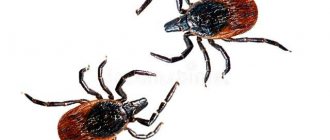What is the danger
Are ticks dangerous for cats or do they only bite dogs?
Many people doubt whether ticks bite cats and believe that this type of parasite does not affect them. It is a myth. Representatives of Ixodidae bite everyone. It’s just that dogs constantly visit the street and parasitic diseases are recorded more often in them.
The Ixodid tick is a small spider with a disk-shaped body, a small head and 8 legs (see photo).
Color – all shades of brown. Females drink more blood. If the parasite is hungry, its body is approximately 2-4 mm in size. But the gluttony is surprising. The body weight of females increases 80-120 times during feeding. When she drinks blood, she is able to swell into a ball up to 1.5 cm, and the color changes from brown to dirty gray.
The danger for cats lies in the ability of ixodids to be carriers of various serious diseases. The culprits of diseases are protozoan parasites and viruses that live in the body of an ectoparasite.
The consequences of a bite are manifested by such infectious diseases as:
- hemabartonellosis;
- borreliosis;
- theileriosis;
- piroplasmosis;
- babesiosis
Any parasitic disease does not develop immediately after a bite. Time must pass - on average 2-3 days, sometimes more.
How difficult the disease will be depends on a number of factors:
- the general well-being of the animal and the state of immunity;
- age;
- number of bitten bloodsuckers;
- timeliness of measures taken by the owner.
Pregnant cats and kittens are especially at risk. If an infection or virus enters the body of a pregnant animal, then the offspring will also be affected.
Prevention of infection
In the first month after a tick bite, you need to carefully monitor the animal’s condition, tracking any changes in its behavior. This is how long the incubation period of infectious diseases carried by ixodid parasites lasts. In addition, allergies may develop. The following signs should alert you:
- poor appetite;
- lethargy;
- weight loss;
- dull coat;
- presence of itching;
- heat;
- change in urine color;
- problems with stool.
Cats are vaccinated against encephalitis - preventive immunoglobulin is administered. The vaccine is paid, but the safety and health of your beloved pet is worth it.
The principle of action of the tick
It takes the female parasite up to 4 hours to find a suitable place on the cat’s body. That’s why it’s so important to examine the cat immediately after a walk, before the “guest” has time to latch on.
After the location is found, the tick bites the cat’s skin and injects an anesthetic secretion. And only after about a day does it begin to feed on blood. Therefore, the owner has 24 hours to remove the tick from the cat.
Under the influence of incoming warm blood, intracellular parasites are activated in the tick's intestines, begin moving through the bloodstream and end up in the saliva.
The female swells up from drinking blood, increases significantly in size and splashes out excess liquid in the form of saliva. Pathogens enter the animal’s blood through the wound.
If a tick is found already filled with blood, and it turns out to be a carrier, then the cat is infected. In such a situation, it does not play a big role when to remove the tick from the cat’s body. But the fact is that 10 individuals can sit on a cat and all of them will turn out to be harmless, or maybe one will be a carrier of a serious disease. In any case, if a cat is bitten, you cannot immediately begin treatment; perhaps the parasite is not contagious, and all medications have side effects.
If the head remains
The head left under the skin is almost always clearly visible. Removing it will not be difficult. You should arm yourself with a sewing needle, disinfect it, and pick out the rest of the insect. After this, treat the wound with an antiseptic. If it does become inflamed later, you can use a hydrocortisone spray.
Signs of a bite
A tick on a cat may not be immediately noticed by the owner or may not be noticed at all. The female drinks blood for 5-7 days, then she falls off the body to lay eggs in a secluded place. Therefore, if a small bloodsucker is found on a cat and she has symptoms of malaise, this does not mean that it is the cause. Most likely the culprit is another specimen that has already fallen off the body.
You should be wary if your pet exhibits the following signs:
- lethargy;
- depressed state;
- loss of interest in the game;
- lack of appetite;
- elevated temperature – in cats it is over 39 degrees;
- dark colored urine;
- shortness of breath, cough;
- unsteady gait;
- yellowing of the eyes.
If a cat is bitten by a tick, symptoms of the disease appear between 3 days and 3 weeks after the bite. It is not necessary that all signs will appear, there may only be one. The owner needs to monitor the pet and measure the temperature up to 5 times a day. If there is a deviation from the norm, immediately contact a veterinary clinic. The success of treatment depends on early detection of the disease, correctly selected medications and the cat’s immunity.
Fact: Female ticks are among the most fertile. During their life they lay up to 20 thousand eggs.
Preventive measures
It is always better to prevent a situation than to look for solutions later. To do this, you need to be careful about protecting your cat. You can purchase a spray or collar at any pet store or veterinary pharmacy; they will protect your pet from insect attacks. You can consult your doctor before purchasing.
In order to avoid complications, you should take vaccination responsibly, that is, do all vaccinations in a timely manner. This attitude of the owner towards his animal will protect him from sad consequences. And even with a tick bite, from which no one is protected, the risks of infection are reduced to zero.
Bite sites
Is it true that ticks love to live on oak trees and fall onto walking cats from tree branches?
It is wrong to think so. Ixodid ticks do not climb to a height of more than one and a half meters. The main habitat is grass, including dry grass and shrubs.
Even a completely domestic cat becomes a victim of the parasite if the owner brought it into the house on his clothes. An ectoparasite can hide for several days or even weeks and then bite a cat.
Fact: Ixodids tolerate drought, lack of food, and sharp drops in temperature because they can slow down their development at any stage. An adult can easily go without food for up to 2 years.
Parasites, having landed on an animal’s body, look for a place where the skin is thinner so that it is easier to bite through and where the animal cannot shake it off with its paw or reach with its tongue. The main weapon of a tick is a proboscis with jaws and tentacles. With its jaws it cuts the skin of the animal and attaches itself with them.
The most popular places are:
- withers;
- stomach;
- groin;
- armpit area;
- behind the ears.
On short hair, parasites are clearly visible, but long-haired cats need to be combed with a comb against the direction of hair growth. If a cat has been bitten by a tick, stroking it with the palm against the fur will help find it. A lump will be revealed to the touch.
How not to pull it out
Seeing a small spider on a pet, many owners panic and often make mistakes:
- They fulfill their first desire - to rip off the parasite
There should be no sudden movements or jerks. They pull it out with twisting movements in one direction so that the spines on the proboscis do not puff up, but press against it. This is the only way to remove the parasite along with the head.
- Lubricated with oil
Vaseline, vegetable oil, and machine oil are used to cut off oxygen to the parasite. The effect will be that the tick will not like this method, and it will begin to move backwards, perhaps even falling off the cat’s body. However, while this happens, he will have time to inject infected saliva. The moment has passed.
- They're putting pressure
By crushing a tick with your fingers, the cat owner increases the risk of infected blood getting into the wound.
What to do
Every situation is different. If your cat is running around with part of a tick inside, they may not even realize it, but it's always a good idea to talk to your vet; in some cases, you may need to take steps to prevent an infestation.
- Disinfect the area
In situations where part of a tick becomes lodged in your pet, it is important to disinfect the area, some people do this by wiping it with alcohol (or a suitable disinfectant) and observing your pet so you can take action if necessary.
It is important not to treat the area with alcohol or disinfectant if the tick is still attached, as this may increase the risk of disease transmission.
© shutterstock
- Visit your veterinarian
In cases where the affected area becomes red, swollen or painful, or has a draining wound, it is time to make an appointment with your veterinarian right away.
Your veterinarian will be able to advise you on the best course of action depending on whether the mite remains are harmful to your cat or not.
If the affected area is already infected, your veterinarian may prescribe a topical antibiotic or a course of oral antibiotics for treatment.
Caring for your cat after tick removal
When the process of removing a tick at home has been successful, you need to carry out a number of control measures:
- If the wound is clean, treat it with any antiseptic: iodine, hydrogen peroxide, alcohol, brilliant green.
- If the head remains in the wound, it must be carefully removed with tweezers and the bite site disinfected. It is better not to use a needle, there is a risk of picking more of the wound. If you leave the head, there may be a complication in the form of inflammation, like with a splinter.
It is not always possible to free the bite site from the remains of the tick. In this case, the hair is clipped and the wound is lubricated with chlorhexidine (0.05%) twice a day to prevent inflammation. Over time, the cat’s body itself will reject the foreign body. The head will come out with pus. The second option is that it will become overgrown with connective tissue and a compaction will form under the skin. If swelling and redness appear, you should consult a doctor, as there may be an abscess that needs to be opened. However, this does not happen often.
Can a tick hide under the skin?
Ixodids do not live under the skin. They can sit on a cat for a month, but will not completely move under the skin.
The vector tick and the regular tick do not differ in appearance. Moreover, if the owner reacted quickly, then it is not a fact that the carrier managed to infect the cat. There is no point in immediately taking the cat to the veterinary clinic to donate blood for analysis. Protozoa appear in the animal’s blood only after 3-4 days. If you donate blood on the first day of the bite, the result, even if it is negative, is considered false.
The analysis is carried out twice with an interval of 5-7 days.
Preliminary preparation
First, prepare the necessary tools. If you often encounter this problem, I recommend purchasing a tick-twister - this is a special tool for removing ticks, sold in pet stores. When a tick-twister is not at hand, regular tweezers will do.
It is highly not recommended to carry out manipulations with bare hands. There is a high probability that you will miscalculate the force and crush the parasite, and part of its body will remain under the cat’s skin. This is fraught with further infection and penetration of infection.
You will need disposable gloves, a container for the removed tick (preferably with alcohol), and wound-healing ointment.









